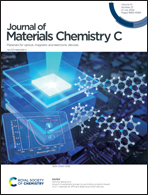Dithienylnaphthalenes and quaterthiophenes substituted with electron-withdrawing groups as n-type organic semiconductors for organic field-effect transistors†
Abstract
We hereby report a successful design strategy for n-type semiconductor materials based on an analogy with efficient p-type semiconductors, by introducing electron-withdrawing groups while maintaining the symmetry of the molecules upon omitting one thiophene unit on each side of the oligoaryl core. Two series of dithienylnaphthalenes and quaterthiophenes substituted with various electron-withdrawing groups have been synthesised using Suzuki or Stille cross-coupling, and Knoevenagel condensation as key steps. The comparison of theoretical and experimental molecular properties related to the effect of electron-withdrawing groups is presented. Both the DFT-calculated and experimentally determined values of the energy gap between frontier orbitals have shown a decreasing trend in the order of perfluoroalkyl, acyl, perfluoroacyl, nitro, alkyldicyanovinyl and perfluoroalkyldicyanovinyl in both series. The X-ray analysis of five derivatives revealed almost planar geometry of the oligoaryl core with a herringbone or lamellar packing motif. The crystal structures of quaterthiophenes exhibited an s-cis conformation between the outer thiophenes in the crystals, in contrast to the theoretical prediction. Carbonyl-based compounds showed n-type behaviour as an active layer in OFET devices with an electron mobility of up to 0.57 cm2 V−1 s−1.



 Please wait while we load your content...
Please wait while we load your content...